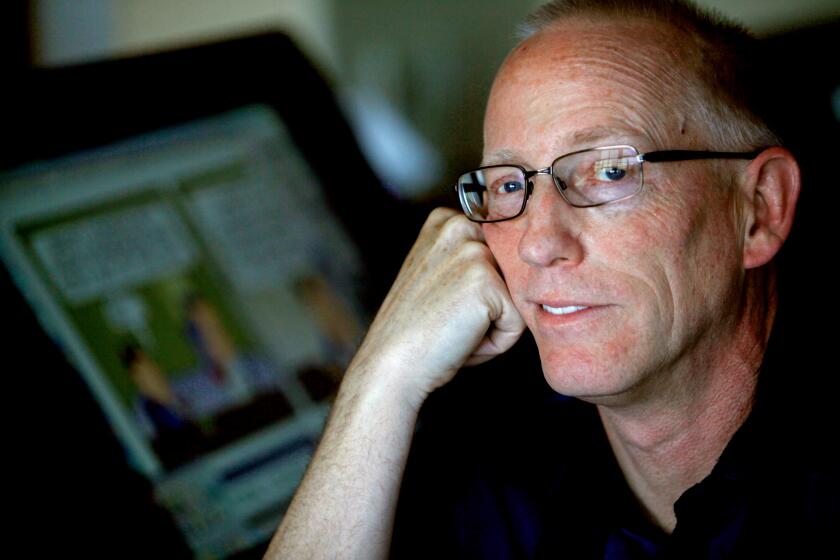Buzzing over the bees’ plight
- Share via
In Jerry Seinfeld’s “Bee Movie” of four years ago, a talking bee decides to sue the human race after finding out people exploit the insects and sell their honey. But, in fact, the bees were facing a much more dire situation.
That year, news began to surface about honeybees fleeing their hives and dying en masse. Known as colony collapse disorder, the phenomenon is global, affecting farmers not only in the U.S. but also around the world, from Argentina and France to New Zealand and Taiwan. Honeybees, which contribute to one out of every three bites of food globally due to their role as pollinators, are disappearing at the rate of roughly 30% each year, according to the U.S. Department of Agriculture.
A single story about colony collapse disorder inspired not one but two sets of documentary filmmakers to look into the mysteries behind the problem. Coincidentally, both films are now finally hitting screens: Taggart Siegel’s “Queen of the Sun,” and “Vanishing of the Bees,” by Maryam Henein and George Langworthy.
Shown in limited theater screenings this spring, “Vanishing of the Bees” was added to iTunes this month and released on DVD. “Queen of the Sun” opened Friday for a one-week run at the Laemmle Monica 4-Plex and Laemmle Fallbrook.
One would think that two films on the same subject filmed in the same genre released at the same time would prompt a rejiggering of release dates or some sort of marketing gamesmanship, but the filmmakers don’t view one another as competition.
“It’s all for a really good cause,” said Siegel, a Portland, Ore.-based documentarian best known for “The Real Dirt on Farmer John.” “It’s an emergency we’re in. This pollinator that keeps the world abloom, there’s room for more and more coverage. I don’t think you could ever saturate the market completely because everybody does it differently.”
Though both films delve into the causes of colony collapse disorder and both feature interviews with liberal foodie intellectual Michael Pollan and biodynamic farmer Gunther Hauk, their presentations are quite different. “Queen of the Sun” is more of a love letter to the honeybee — a color-saturated ode to the insect and its amber byproduct that’s likely to appeal to urban homesteaders.
Cast with entomologists, beekeepers, philosophers, biochemists, academics, authors and activists, “Queen of the Sun” is a hive unto itself. Rather than follow a single character, it pulls from a wide-ranging cast of eccentric characters as it globe trots and delves into the history and significance of honeybees and their plight.
“Vanishing of the Bees” is more politically and scientifically oriented. Narrated by Oscar nominee Ellen Page, it’s an eco-whodunit on par with “Who Killed the Electric Car.” Formatted like a mystery, it opens with David Hackenberg, the Florida beekeeper who first identified colony collapse disorder in the U.S. when he discovered 400 of his ordinarily buzzing beehives were empty. The honeybees had fled. Their striped bodies were never found.
The film proceeds to follow Hackenberg and fellow beekeeper David Mendes as they consider possible causes for a phenomenon that’s been documented in 35 states. Cellphones, genetically engineered queen bees, monoculture farming practices and the use of systemic pesticides have all been suggested as culprits.
In both films, the scale of colony collapse disorder, and its implications, seems immense. But neither documentary is fatalistic.
“Environmental documentaries can easily be depressing,” acknowledged Henein.
“We focus on solutions,” added Henein’s co-director Langworthy. “That was one of our aims from the very beginning: to present audiences with very clear ways that they can help the bees, help the environment and help themselves. We feel it’s very important that people feel empowered to make a difference.”
The end of “Vanishing of the Bees” is devoted to those solutions, suggesting that viewers vote with their forks by shopping at farmers markets and growing their own food — even raising their own bees.
That’s what all the filmmakers have been inspired to do since making their documentaries. Heinen buys organic from local markets. Siegel and Langworthy? They’re both backyard beekeepers.
More to Read
The biggest entertainment stories
Get our big stories about Hollywood, film, television, music, arts, culture and more right in your inbox as soon as they publish.
You may occasionally receive promotional content from the Los Angeles Times.










